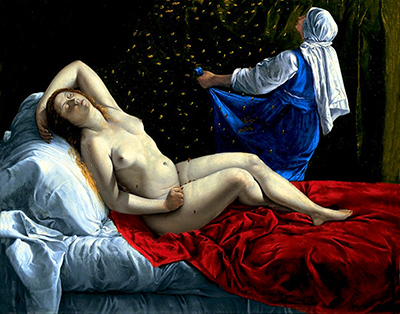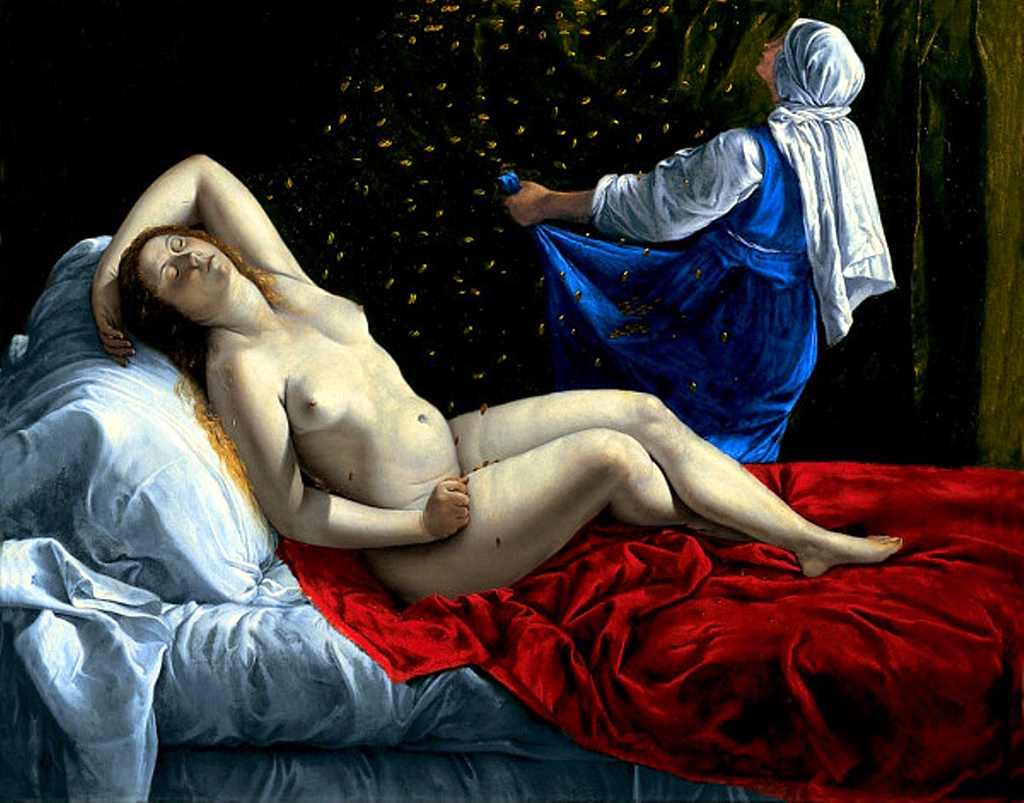Artemisia Gentileschi's Danae is dated at circa 1612, at which point the artist would have been in her late teens. Even at this early stage, she was delivering some extraordinary portraits, as also demonstrated in Susanna and the Elders.
Danae reclines on her bed in this scene, whilst a servant works busily in the background. Her bed is loosely made, suggesting she has moved around in it over night, perhaps restlessly. A stunning red cloth is placed over the top of her white sheets, adding an element of style and also suggesting an affluent setting. Danae's body is honestly captured by the artist, featuring curves which other artists would sometimes reduce down to their idea of a 'perfect' body. Artemisia was more interested in celebrating the female body and preferred realism throughout her career, whatever the impact that it might have on the viewer. The servant at the bottom of the scene is also beautifully dressed, with a bright blue outfit with white headwear. The blue and red tones complement each other and provide the main elements of colour to the overall composition.
The larger image below helps us to see more of the detail in this painting and that includes the golden locks which hang on the shoulders of the young woman as she lies down. Coins fall from above, some of which land on her pale body. She seems unaware of this. The qualities with which the artist captures the various textures of this scene allow us to almost reach out and touch the elements of this painting. We can really imagine the feeling of touching the red cloth or the long hair of Danae. The role of women within the Renaissance and Baroque periods was lesser known as compared with the careers of male artists, and so artists such as Artemisia Gentileschi would serve an important role in reminding us that women were alive and well within society, and could not simply be ignored by the male-centric industries such as the art world. They would also offer an important contrast, stylistically, which occurred naturally as a result of their alternative perspective. This allowed Gentileschi an advantage in one sense, with collectors interested in adding unique items to their collections.
The tale of Danae tells us of how she was forced to remain in her room by King Acrisius of Argos, her father. This comes directly from Greek mythology and many other elements from it have also been used to inspire art over recent centuries. Danae was kept away in order to protect her becoming pregnant, after a prediction was made of this. In response to this Zeus would overcome their attempts by entering the room as a shower of gold, as displayed by Gentileschi in this painting. Perseus would be their son. Greek mythology has often given artists some dramatic scenes to work from, also with some elements of fantasy which have given them greater scope than would otherwise be possible. Such items would probably have not been allowed normally, if directly from one's own imagination, but because they come from respected tales of mythology, then academics of the time were much more accepting. This fashion would then influence later generations of artists, who would be inspired to produce their own take on the same themes and subjects.
The difficulties faced by women could also provide the drive and inspiration needed to produce the best artwork, and Gentileschi would channel the trauma of her own life into her work. The appaling rape would encourage her to focus on strong female figures within many of her paintings and this perhaps helped her to establish herself as a female icon for many in today's world. To overcome obstacles such as she had done and still produce an influential career is highly inspiring to many people around the world, and not just women. Her unique role as a woman in the Baroque era has also increased the value of her work in recent years, with few artists of this gender available to galleries that focus on that period of European art history. Many more have appeared over the last century or so, and therefore you will find contemporary art galleries to be naturally more diverse, without a massive conscious effort needing to be made.
This topic has been covered by a huge number of artists over the years, with some of the most memorable being versions by Rembrandt van Rijn, Gustav Klimt plus several by Titian. It is interesting to compare each of these alternative interpretations, particularly considering the variety in style of some of these artists. Klimt's for example for arrive many centuries later and provide a very different approach, in terms of colour, posture and perspective. Mythological and religious themes have been addressed over many centuries and provide a quick way of comparing different artists and movements, with Danae being just one example of that. Indeed, most artists will have studied the work of artists from the past and then taken ideas from their interpretations into their own careers, ensuring the path of influence continues onwards. Society changes over time, and so the ways in which artists see and depict different topics and themes will also change in line with that.
This delightful portrait can now be found in the collection of the Saint Louis Art Museum, USA. The institution hosts a wide array of items from all manner of different cultures and civilisations, making it the sort of place which can appeal to almost any taste. In terms of painting, their main focus is on American and European art, and some of the highlights to be found here includes Long Live Love or Charming Country by Max Ernst, Madame Roulin by Paul Gauguin, Composition of Red and White: Nom 1/Composition No. 4 with red and blue by Piet Mondrian, Judith and Holofernes by Giorgio Vasari and also Number 3, 1950 by Jackson Pollock. Even that small selection underlines the breadth of styles found here, with everything from the early Renaissance up to the New York School covered.





